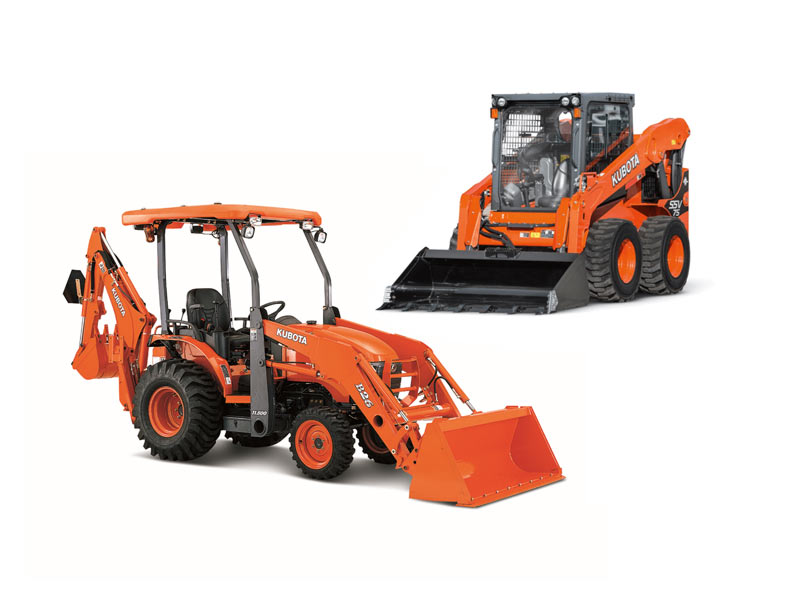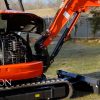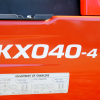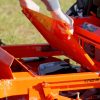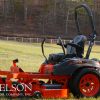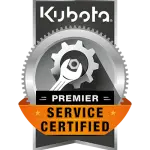When it comes to adaptability and versatility, both the skid steer and the compact tractor loader backhoe are at the top of the list for equipment. Each have numerous attachments and some of those attachments can be interchanged between both of the machines. Even though the two have a lot in common and possess some of the same features, each have their own place on the job site that makes them valuable.
What’s a tractor loader backhoe (TLB)?
A compact tractor loader backhoe is a machine with a digging depth of 12 feet or less and a horsepower rating at 80 or less. However, what makes a TLB compact is more the weight and how well it maneuvers, as opposed to digging depth and horsepower. Its compact size and easy maneuverability makes moving the machine efficiently through tight spaces, all around the jobsite, and from job to job easy.
Compact track loader backhoes are particularly appropriate for jobs in small spaces and on sites where it is necessary to protect the turf from damage. These machines are typically used on all kinds of different job sites. For instance, you’ll find TLBs at construction and demolition sites, driven by landscaping and nursery maintenance workers, and at utility and recycling repair companies.
Municipalities prefer tractor loader backhoes for their versatility and speed – city workers need to accomplish many different kinds of tasks at a variety of job sites. track loader backhoes are very versatile and make use of many different attachments for specific tasks, and their speed allows workers to drive them from one site to another. TLBs sometimes cannot fit into spaces that the skid steer can, but may be a better choice because they cause less damage to turf and other less compacted surfaces.
What’s a skid steer?
View the skid steer as a power head for multiple attachments. Their compact size makes them suitable for a variety of applications and their superior maneuverability and ability to turn in their own tracks makes them ideal for areas where larger machines cannot fit.
Skid steers come in several sizes for different types of jobs and job sites. Small-frame skid steers are commonly used for landscaping, building, underground and interior construction, due to their compact size.
Medium-size skid steers with 50 to 70 HP engines are the most popular type of skid steer. Their relatively small size, balance, and power make this size well suited to a lot of different jobs. When a construction site needs more power and bigger bucket size, but big tractors won’t fit, medium-frame skid steers are often the perfect solution.
Larger loaders provide the muscle needed for big construction jobs, and the versatility to tackle excavation, dozing, and clearing, while still providing superior maneuverability.
Skid steer attachments include buckets, graders, rollers, pallet forks, root grapples, bale spears, augers, and many more options. With the right assortment of implements, this versatile little engine can do dozens of mighty big jobs.
When is a skid steer more useful than a tractor loader backhoe?
Loading and dumping can be completed with both machines, but when a skid steer is equipped with a backhoe attachment, it has to be removed to return to the loader. The skid steer makes switching from backhoe to loader quick and easy, but it does take a little extra time between loading and dumping compared to a track loader backhoe, which already features both attachments.
For smaller job sites, a skid steer with a backhoe attachment is preferable. The skid steer is more compact and features superior maneuverability in tighter spaces.
The skid steer and compact track loader backhoe have a lot in common, however, they are still very different machines. Skid steers excel at the job they were primarily intended for, handling debris with a loader.
When moving between multiple nearby job sites, the compact track loader backhoe is faster on the road. If your job includes preparing homesites for a neighborhood development, for example, the compact TLB can be driven quickly between jobs, saving transport time.
It all comes down to the job.
Both machines have their place on the work site, but it comes down to the versatility of functions. The skid steer has an available attachment for almost any job making it the complete package. This cannot be said of the compact track loader backhoe, which comes with just a front-end loader and backhoe. Compact track loader backhoes have more maneuverability in large areas; skid steers are more compact for tight spaces.
Both skid steers and compact TLBs are great choices. To decide which is best for your job, evaluate the job site, tasks that need to be accomplished, and time constraints. With an open job site and multiple tasks, the track loader backhoe will be a time saver. With a tighter job site or the need to change job sites frequently to accomplish the same task, a skid steer will get the job done faster and more efficiently.
Image source: Kubota


